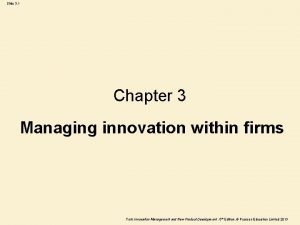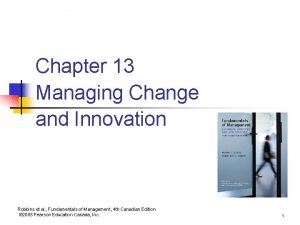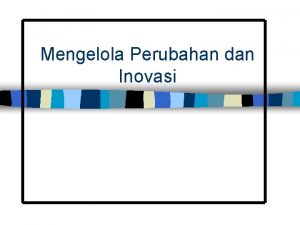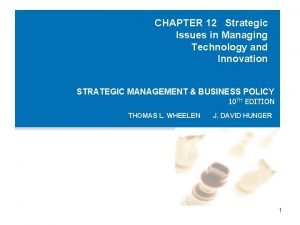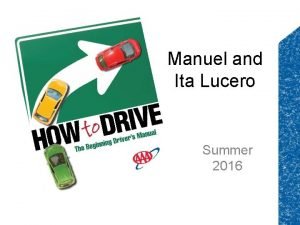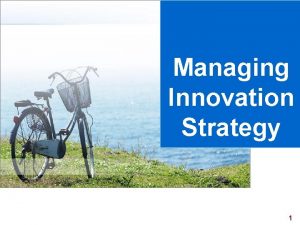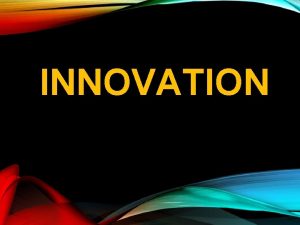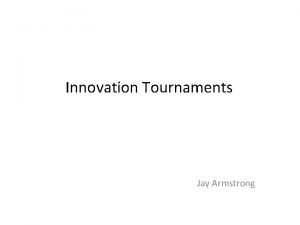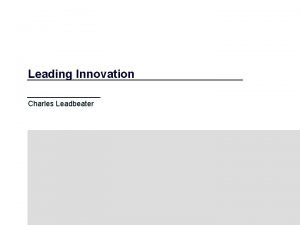Slide 3 1 Chapter 3 Managing innovation within
















- Slides: 16

Slide 3. 1 Chapter 3 Managing innovation within firms Trott, Innovation Management and New Product Development , 5 th Edition, © Pearson Education Limited 2013

Slide 3. 2 Trott, Innovation Management and New Product Development , 5 th Edition, © Pearson Education Limited 2013

Slide 3. 3 Figure 3. 1 Managing the tension between the need for creativity and efficiency Trott, Innovation Management and New Product Development , 5 th Edition, © Pearson Education Limited 2013

Slide 3. 4 Figure 3. 2 Pearson’s uncertainty map Source: A. W. Pearson (1991) ‘Managing innovation: an uncertainty reduction process’, in Managing Innovation, J. Henry and D. Walker (eds), Sage/OU. Trott, Innovation Management and New Product Development , 5 th Edition, © Pearson Education Limited 2013

Slide 3. 5 Figure 3. 3 Matrix of complexity of architectural/component knowledge Source: Architectural Innovation: The Reconfiguration of Existing Product Technologies and the Failure of Established Firms, Administrative Science Quarterly, Vol. 35, No. 1 (Henderson, R. and Clark, K. 1990). Reproduced with permission of Johnson at Cornell University. Trott, Innovation Management and New Product Development , 5 th Edition, © Pearson Education Limited 2013

Slide 3. 6 Figure 3. 4 A two-dimensional typology of innovation projects Trott, Innovation Management and New Product Development , 5 th Edition, © Pearson Education Limited 2013

Slide 3. 7 Figure 3. 5 Innovation stimulus, capacity and performance Source: D. I. Prajogo and P. K. Ahmed (2006). Trott, Innovation Management and New Product Development , 5 th Edition, © Pearson Education Limited 2013

Slide 3. 8 Figure 3. 6 Critical factors for innovation success Source: van der Panne et al. (2003). Trott, Innovation Management and New Product Development , 5 th Edition, © Pearson Education Limited 2013

Slide 3. 9 Table 3. 1 Innovation management measurement areas Source: Adams et al. (2006). Trott, Innovation Management and New Product Development , 5 th Edition, © Pearson Education Limited 2013

Slide 3. 10 Summary of the organisational characteristics that facilitate the innovation process Table 3. 2 Trott, Innovation Management and New Product Development , 5 th Edition, © Pearson Education Limited 2013

Slide 3. 11 Figure 3. 7 Technological linkages among different types of firms Source: K. Pavitt (1994) Sectoral patterns of technological change: towards a taxonomy and theory, Research Policy, Vol. 13, 343 – 73. Trott, Innovation Management and New Product Development , 5 th Edition, © Pearson Education Limited 2013

Slide 3. 12 Table 3. 3 Organic versus mechanistic organisational structures Source: D. P. Slevin and J. G. Covin (1990) Juggling entrepreneurial style and organizational structure: how to get your act together, Sloan Management Review, Winter, 43 – 53. Trott, Innovation Management and New Product Development , 5 th Edition, © Pearson Education Limited 2013

Slide 3. 13 Table 3. 4 Key individual roles within the innovation process Source: Based on E. B. Roberts and A. R. Fushfield (1981) Staffing the innovative technology-based organisation, Sloan Management Review, Spring, 19 – 34. Trott, Innovation Management and New Product Development , 5 th Edition, © Pearson Education Limited 2013

Slide 3. 14 Figure 3. 8 Paradox of ERP systems and innovation organisational requirements Trott, Innovation Management and New Product Development , 5 th Edition, © Pearson Education Limited 2013

Slide 3. 15 Table 3. 5 Innovation management tools and methodologies Source: Hidalgo and Albors (2008) and Coombs et al. (1998). Trott, Innovation Management and New Product Development , 5 th Edition, © Pearson Education Limited 2013

Slide 3. 16 Table 3. 5 Innovation management tools and methodologies (Continued) Source: Hidalgo and Albors (2008) and Coombs et al. (1998). Trott, Innovation Management and New Product Development , 5 th Edition, © Pearson Education Limited 2013
 Managing innovation within firms
Managing innovation within firms Managing change and innovation
Managing change and innovation Chapter 13 managing change and innovation
Chapter 13 managing change and innovation Ano ang heel and toe polka
Ano ang heel and toe polka Besigheidsplan
Besigheidsplan Radical innovation vs disruptive innovation
Radical innovation vs disruptive innovation Mengelola perubahan organisasi dan inovasi
Mengelola perubahan organisasi dan inovasi Strategic issues in managing technology and innovation
Strategic issues in managing technology and innovation How to do slide and divide
How to do slide and divide Chapter 1 managing risk when driving
Chapter 1 managing risk when driving Chapter 8 managing stress and anxiety
Chapter 8 managing stress and anxiety Chapter 4 managing stress and coping with loss notes
Chapter 4 managing stress and coping with loss notes Distraction factions chapter 8 answers
Distraction factions chapter 8 answers Chapter 8 managing distractions answers
Chapter 8 managing distractions answers Chapter 6 managing weight and body composition
Chapter 6 managing weight and body composition When you apply the ipde process
When you apply the ipde process Chapter 5 managing risk with the ipde process
Chapter 5 managing risk with the ipde process
